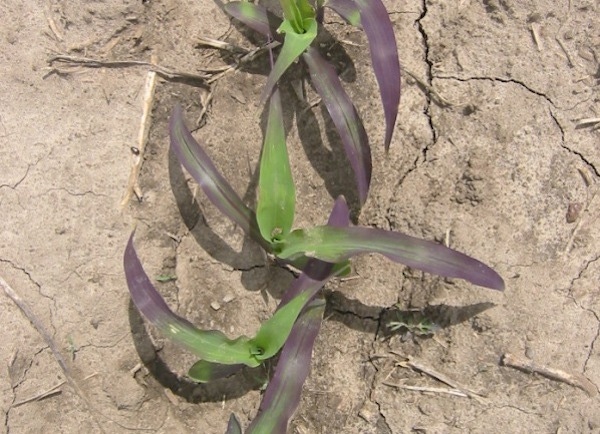June 14, 2013

The corn crop that was planted in May is up and growing in most fields, but there have been numerous reports of fields with uneven plant sizes and colors, including purple and yellow plants. Many corn farmers are wondering if this will decrease potential corn yields.
Based on past experience, many people expect to see purple corn when soils are cool and dry during early plant growth stages, or in that rare field with low soil test phosphorus levels. The purple color is from a pigment that forms when there is more sugar in the leaves than the plant can utilize. Low phosphorus inhibits sugar movement out of leaves, and cool, dry soils reduce root growth and sugar movement to the roots. Both of these increase sugars in the plant and can make the tissue turn purple.
Soils are not cool and dry in Illinois now, but surface soils are drying out in many fields, and it’s likely that roots growth up to now has been restricted some by having soils too wet and in some cases also compacted by tillage and planting operations. In fields where the plants have taken up enough nitrogen and water to grow well but roots remain constricted, purpling might be common now, especially in those hybrids that have a tendency to form the purple pigment.
We expect the problem of purple corn to correct itself as root growth continues. It will help if wet soils continue to dry out, but in fields with dry surface soils, root growth might benefit from some rainfall. The high sugar content that leads to purpling means that the plant is producing sugars through photosynthesis, which is a good sign. There is no evidence that temporary purpling affects yield of the crop, though factors such as soil compaction that can lead to purpling might also reduce yields if the weather is dry later in the season.
Other fields are showing the yellow color that characterized nitrogen deficiency. In some cases this diagnosis is strengthened by our being able to see patterns such as nitrogen applicator knife tracks where the plants are greener. As is the case with purpling, we tend to see more yellow plants in the lower areas of the field. This is both where soils were wetter at planting time, so are more compacted, and where we would expect more N loss and poor root growth due to wet soils.
Read more about purple and yellow corn plants from Emerson Nafziger at University of Illinois.
You might also like:
Fertilizer Delays Cause Concerns
You May Also Like




